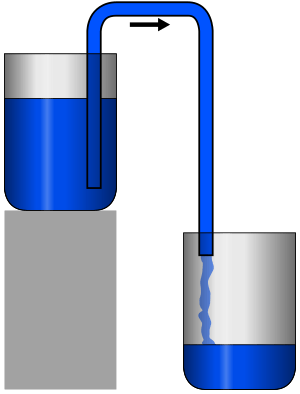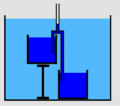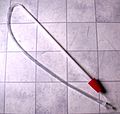Syphon facts for kids

A syphon (also spelled siphon) is a clever tube that moves liquids. Imagine an upside-down U-shaped tube. It can make liquid flow uphill, even higher than where the liquid started! The liquid then comes out at a lower level than its starting point. The best part? It does all this without needing a pump. It uses the natural pull of gravity as the liquid falls down the tube.
For a syphon to work, the tube must be full of liquid and touch the liquid in the upper container (the source). This allows the air around us, called atmospheric pressure, to gently push the liquid up the tube. The lowest pressure inside the tube is at the very top, so the liquid moves towards that spot. This is similar to how a barometer works. The liquid falling on the downhill side creates this lower pressure. A syphon can lift water about 25 feet (around 7.6 meters) above where it started!
Syphons are very useful. They can move water for farming, known as irrigation. While most syphons use water, they can also move other liquids like mercury or even gases like carbon dioxide.
How Does a Syphon Work?
A syphon works because of a few simple science rules. First, the tube must be completely filled with liquid. This is called "priming" the syphon. Once primed, the liquid in the longer, downhill side of the tube is pulled down by gravity.
As this liquid falls, it creates a slight vacuum or lower pressure at the top of the U-bend. The air pressure pushing down on the surface of the liquid in the higher container then pushes that liquid up the shorter side of the tube. It fills the space left by the falling liquid. This continuous push and pull keeps the liquid flowing.
Where Are Syphons Used?
Syphons are used in many everyday situations and industries. They are great for moving liquids from one place to another without needing electricity or a pump.
For example, people use syphons to drain water from fish tanks or to empty fuel from a car's tank (though this should only be done by adults and with care). They are also very common in homebrewing beer to transfer the liquid without disturbing the sediment at the bottom.
In farming, syphons help move water from canals to fields for irrigation. This makes watering crops much easier. You might also find syphon-like actions in your home's plumbing, like in the U-shaped pipes under sinks, which create a water seal to block sewer gases.
Images for kids








